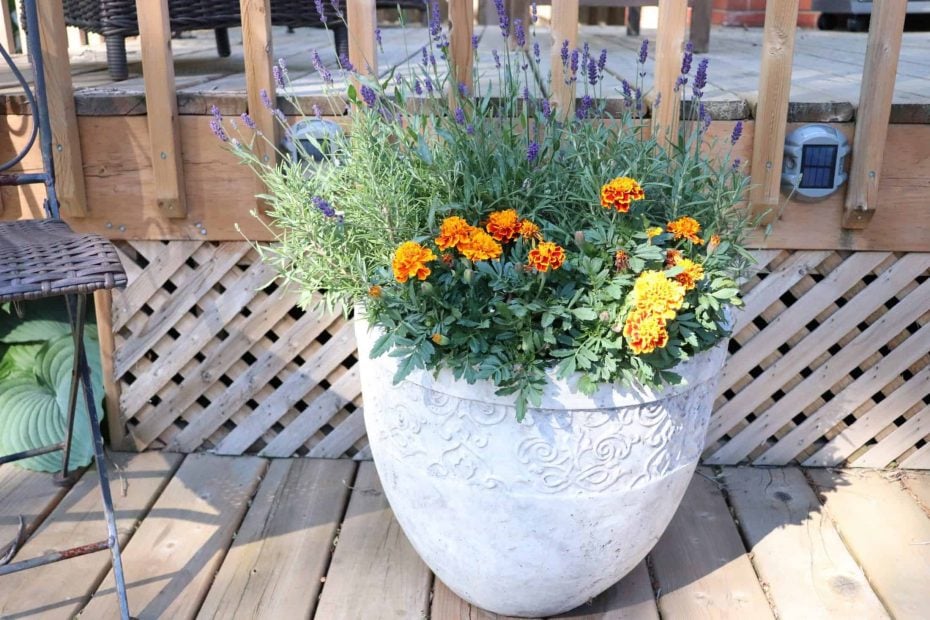How To Make A DIY Mosquito Repellent Planter
Summers are for beaches, BBQs, and mosquitoes. Those little suckers love me and I've tried everything to keep them away. Nothing has worked until now. Here's How To Make A DIY Mosquito Repellent Planter.
The other day my husband and I were chatting about pesky wasps and mosquitoes, after doing some research on plants that can repel bugs, we (okay he) decided to create a unique planter instead of a spray.
Here is your step-by-step guide to make this DIY Planter

First, for this DIY Mosquito Repellent Planter pick a really pretty pot that has holes in the bottom, we used one that is about 2 feet by 2 feet, it is quite large and made from stone.
Next, you want to make sure you pick a good potting mix. We used Black Gold. Organic fertilizer is really important, it's going to help your plants grow and thrive, and it's also free from harmful chemicals and pesticides.
Fill the bottom of the pit with ⅓ potting mix, then, gently loosen the root bulbs before placing them in the pot, add more potting mix, gently patting it down, and leave about an inch of space on the top to allow for gently watering.
A little about the plants we used

Lavender, smells divine and as you probably know can also help with sleep. When used in the garden it acts as a great pesky bug repellent.
The pleasant smell of lavender is offensive to mosquitoes and is best used by planting it in the garden, or in pots situated near doors, windows, and entertainment areas.
Lavender oil contains up to 25 percent linalool, a terpenoid alcohol that contributes to its fruity fragrance. According to the U.S. Environmental Protection Agency, this agent is an active ingredient in more than a dozen registered products used to control mosquitoes outside.
Studies show that linalool has the same effect on mosquito olfactory receptors as diethyltoluamide, a chemical used in many conventional mosquito repellents more commonly known as DEET.
The dried flowers can also be placed in wardrobes to repel moths.
Marigolds will make your landscape more attractive, but marigolds also have a distinct smell that repels mosquitoes.

Rosemary is a herb that many of us are very familiar with and its woody scent is exactly what keeps mosquitoes away.

We planted the lavender at the back, then layered the rosemary in front of that, and finally a layer of the marigolds in the front of the rosemary. From tallest to shortest basically.

And here is it 3 weeks later with the lavender in full bloom!
So easy and effective.
If you want to make sure you place the planter near a window or in the seating area, where we have ours, then you are sure to be mosquito-free!

Now, if this is not your thing, then you can also make my DIY Natural Bug Spray Recipe, which is a safe and natural alternative to DEET. You won't find this recipe anywhere else!
It's important to note that some bugs are crucial to the well-being and biodiversity of our gardens, bees being one of them, you can actually plant certain things that will help attract both bees and butterflies to your garden. And if you are gardening, it's important to keep waste in mind too. I've got a whole post on how to recycle plant pots.
And you can take your eco garden one step further by adding a rain barrel, a compost bin, or even these gorgeous DIY planters, filled with lavender.
If you found this post helpful, please help someone by sharing this article – sharing is caring 🙂!





Mary
says:Is there another flower that can be used instead of marigolds? My hubby is allergic.
Candice Batista
says:Not sure, you’d have to do some research. I have not tired anything else.
Roxana Salcedo
says:try Citronella, you will find it easy
Chanel
says:Thank you for sharing. I am moving into a new home and will try this for my new patio are I will be setting up to hopefully not have too many flying insects.
Susan Huff
says:I would love to learn more about gardening. I plant flowers but I am not good with vegetables.
Gretchen
says:Hi Candace. Thanks for this post. My son is very sensitive to mosquito bites. We usually get our yard sprayed but this year we have HUGE mosquitos. About 2 inches. That are still all over. Hoping this will help. Can they be in partial shade? Thank you
Candice Batista
says:Hi Gretchen,
thanks for your note. Both plants do need full sun. But you can always try.
best,
Candice